Questions with Answers, Solution | Numbers | Chapter 1 | 8th Maths - Exercise 1.6 (Exponents and Powers) | 8th Maths : Chapter 1 : Numbers
Chapter: 8th Maths : Chapter 1 : Numbers
Exercise 1.6 (Exponents and Powers)
Exercise 1.6
1. Fill in the blanks:
(i) (−1)even integer
is _____________.
(ii) For a ≠ 0, a0
is ______________.
(iii) 4-3
× 5-3 __________.
(iv) (-2)-7
= ____________.
(v) (-1/3)-5
= ____________.
2.
Say True or False:
(i) If 8x = 1/64, the value of x is − 2.
(ii) The simplified form of
(256)−1/4 × 42 is ¼.
(iii) Using
the power rule, (37)-2 = 35.
(iv) The
standard form of 2 × 10–4 is 0.0002.
(v) The scientific form of 123.456 is 1.23456×10−2. [Answer: False]
3. Evaluate: 
(i) (1/2)3
Solution:
(1/2)3 = 13/23 = 1 / [2 × 2 × 2]
= 1 / 8
(ii) (1/2)−5.
Solution:
(1/2)−5 = 1−5 / 2−5 = 1 / 2−5
= 25 = 2 × 2 × 2 × 2 × 2 = 32
(iii) (−5/6)−3
Solution:

(−5/6)−3 = (−5)−3 / 6−3 = 63
/ (−5)−3 = ( (6 × 6 × 6) / (−5 × −5 × −5) ) = − 216/125
(iv) (2−5 × 27) ÷ 2−2
Solution:
(2−5 × 27) ÷ 2−2 = (2−5+7)
÷ 2−2
= 22 ÷ 2−2
= 22+2
= 24 = 16
(v) (2−1 × 3−1)
÷ 6−2
Solution:
(2−1 × 3−1) ÷ 6−2 = (2 ×
3)−1 ÷ 6−2
= (6)−1 ÷ 6−2
= (6)−1 – (−2) = 61 = 6
4. Evaluate: 
Solution:
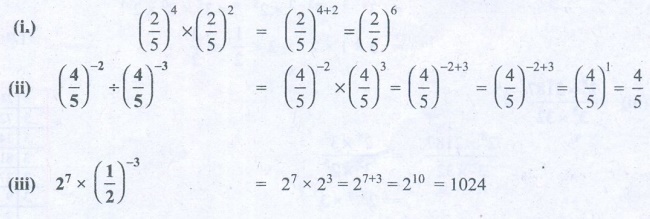
(2/5)4
× (2/5)2 = (2/5)4+2
= (2/5)6
(ii) (4/5)−2 ÷ (4/5)−3 = (4/5)−2
× (4/5)3 = (4/5)−2+3 = (4/5)−2+3 = (4/5)1 = 4/5
(iii) 27 × (1/2)−3 = 27 × 23 = 27+3
= 210 = 1024
5. Evaluate: (i) (50 +6-1) × 32 (ii) (2-1 + 3-1 ) ÷ 6-1 (iii) ( 3-1 + 4-2 + 5-3)0
Solution:
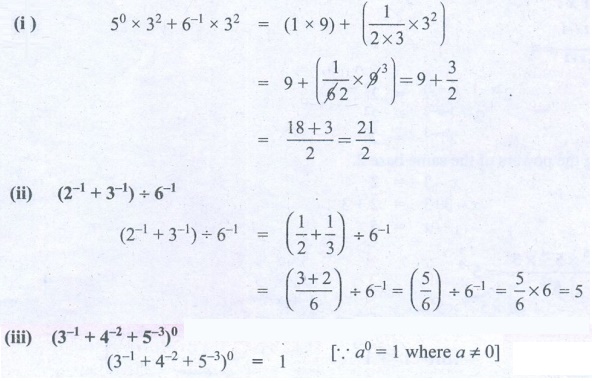
(i) (50 +6−1)
× 32
50
× 32 + 6−1 × 32 = (1 × 9) + ( {1 / [2×3]} × 32)
= 9 + ( 1/6
× 9 ) = 9 + 3/2
= [18 + 3] /
2 = 21/2
(ii) (2−1 + 3−1) ÷ 6−1
(2−1 + 3−1) ÷ 6−1
= (1/2 + 1/3) ÷ 6−1
= ( [3 + 2]
/ 6) ÷ 6−1 = (5/6) ÷
6−1 = 5/6 × 6 = 5
(iii) (3−1 + 4−2 + 5−3)0
(3−1 + 4−2 + 5−3)0
= 1
[∵ a0 = 1
where a ≠ 0]
6. Simplify: (i) (32)3 × (2×35)–2 × (18)2

Solution:
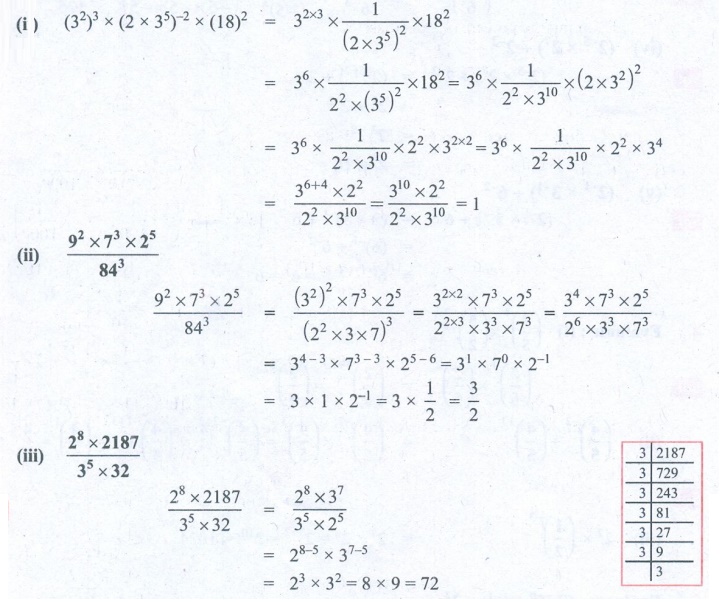
(i) (32)3 × (2 × 35)−2 × (18)2
(32)3
× (2 × 35)−2 × (18)2 = 32x3 × [1 /
(2 × 35)2 ] × 182
= 36
× [1 / 22×(35)2 ] × 182 = 36
× [ 1 / 22×310 ] ×
(2×32)2
= 36
× [ 1 / 22×310 ] ×
22 × 32×2 = 36
× [ 1 / 22×310 ] × 22 × 34
= [36+4
× 22 ] / [22 × 310
] = [310 × 22 ] / [ 22 × 310 ] = 1
(ii) [ 92 × 73 × 25 ] / 843
[ 92
× 73 × 25 ] / 843 = [ (32)2
× 73 × 25 ] / [ (22 × 3 × 7)3 ] = [
32x2 × 73 × 25 ] / [ 22x3x 33
× 73 ] = [ 34 × 73 × 25 ] / [ 26
× 33 × 73 ]
= 34−3
× 73−3 × 25−6 = 31 × 70 × 2−1
= 3 × 1 × 2−1
= 3 × (1/2) = 3/2
(iii) [ 28 × 2187] / [35 × 32]
Solution:

[28
× 2187] / [35 × 32] = [28 × 37 ] / [ 35
× 25]
= 28−5
× 37−5
= 23 × 32 = 8 × 9 = 72
7. Solve for x: 
(i) 22x−1 / 2x+2
= 4
Solution:
22x−1
–(x+2) = 22
22x−1
–x−2) = 22
2x−3
= 22
Equating the
powers of the same base 2.
x−3 = 2
x – 3 + 3 = 2 + 3
x = 5
(ii) [ 55 × 5−4 × 5x ] / 512
= 5−5
[ 55 × 5−4 × 5x ] / 512
= 5−5
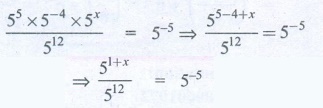
⇒ [ 55 −4 + x ] / 512 = 5−5
⇒ 51+ x / 512 = 5−5
⇒ 51+ x − 12 = 5−5
⇒ 5 x −11 = 5−5
Equating the powers of same base 5.
x − 11 = −5
x —11 + 11 = −5 + 11
x = 6
8. Expand using exponents: (i) 6054.321
(ii) 897.14
(i) 6054.321 = (6 × 1000) + (0 × 100) + (5 × 10) + (4 × 100) +
3/10 + 2/100 + 1/1000
= (6 × 103) + (5 × l01) + (4 × 100)
+ ( 3 × 1/10) + ( 2 × 1/100) + (1 × 1/1000)
= (6 × 103) + (5 × l01) + (4 × 100)
+ ( 3 × 10−1) + ( 2 × 10−2) + (1 × 10−3)
(ii) 897.14 = (8 × 100) + (9 × 10) + (7 × 100) + l/10 + 4/100
= (8 × 102) +
(9 × 101) + (7 × 100) + (l × 1/10) + (4 × 1/100)
= (8 × 102) +
(9 × 101) + (7 × 100) + (l × 10−1) + (4 × 10−2)
9. Find the number in standard form for
the following expansions:
(i) 8×104 +7×103
+6×102
+5×101
+2×1+ 4×10-2 +7×10-4
(ii) 5×103
+ 5×101 + 5×10–1
+ 5 ×10–3
(iii) The radius of a hydrogen atom is
2.5 × 10–11 m
Solution:
(i) 8 × 104 + 7 × 103 + 6 × 102 + 5 × 101 + 2 × 1 + 4 × 10−2
+ 7 × 10−4
(8 × 104) + (7 × 103) + (6
× 102) + (5 × 101)
+ (2 × 1) + (4 × 10−2) + (7 × 10−4)
= (8 × 10000) + (7 × 1000) + (6 × 100) + (5 × 10) + (2 × 1) + (4
× 1/100) + (7 × 1/10000)
= 80000 + 7000 + 600 + 50 + 2 + (4/100) + (7/10000)
= 87652.0407
(ii) 5 × 103 + 5 × 101 + 5 × 10−1
+ 5 × 10−3
Solution:
5 × 103 + 5 × 101 + 5 × 10−1 +
5 × 10−3
= 5 × 1000 + 5 × 10 + 5 × 1/10 + 5 × 1/1000
= 5000 + 50 + 5/10 + 5/1000 = 5050.505
(iii) The radius of a hydrogen atom is 2.5 × 10−11 m.
Solution:
Radius of a hydrogen atom = 2.5 × 10−11 m
= 2.5 × 1/1011 m = 2.5/1011m =
0.000000000025 m
10. Write the following numbers in scientific
notation:
(i) 467800000000 (ii) 0.000001972 (iii)
1642.398
(iv) Earth’s volume is about 1,083,000,000,000
cubic kilometres
(v) If you fill a bucket with dirt, the
portion of the whole Earth that is in the bucket will be 0.0000000000000000000000016
kg
Solution:

Objective
Type Questions
11. By what number should (−4)−1 be
multiplied so that the product becomes 10-1 ?
(A) 2/3
(B) −2/5
(C) 5/2
(D) −5/2
[Answer: (B) −2/5]
Solution:
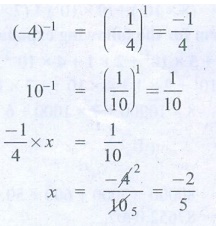
(−4)−1 = (−1/4)1 = −1/4
10−1 = (1/10)1 = 1/10
(−1/4) × x = 1/10
x
= −4 / 10 = −2 / 5
12. (−2)−3 × (−2 )−2
= ____________.
(A) −1/32
(B) 1/32
(C) 32
(D) –32
[Answer: (A) −1/32]
13. Which is not correct?
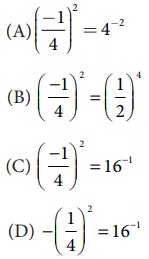
[Answer: (D) –(1/4)2 = 16−1]
Solution:
(−2) – 3x( − 2) – 2 = (−2) – 3 – 2 = (−2)
−5 (−1/2)5 = −1/32
14. If 10x/10-3 =109 ,then x is ____________.
(A) 4
(B) 5
(C) 6
(D) 7
[Answer: (C) 6]
15. 0.0000000002020 in scientific form
is ____________.
(A) 2.02×109
(B) 2.02×10−9
(C) 2.02×10−8
(D) 2.02×10−10
[Answer: (D) 2.02 × l0−10]
Solution: 
Answer
Exercise 1.6
1. (i) 1 (ii) 1 (iii) 20−3
(iv) −1/128 (v) –243
2. (i) True (ii) False
(iii) False (iv) True (v) False
3. (i) 1/8 (ii) 32
(iii) – 216/125 (iv) 16 (v) 6
4. (i) 64/15625 (ii) 4/5
(iii) 1024
5. (i) 21/2 (ii) 5 (iii)
1
6. (i) 1 (ii) 3/2
(iii) 72
7. (i) x = 5
(ii) x = 6
8. (i) 6 × 103
+ 5 × 101 + 4 × 100 + 3 × 10‒1 + 2 × 10‒2
+ 1 × 10-3
(ii) 8 × 102
+ 9 × 101 + 7 × 100 + 1 × 10‒1 + 4 × 10‒2
9. (i) 87652.0407 (ii)
5050.505 (iii) 0.000000000025
10. (i) 4.678 × 1011
(ii) 1.972 × 10‒6 (iii) 1.642398 ×103 (iv) 1.083 ×1012
cu. km (v) 1.6 ×10‒24
11. (B) -2/5
12. (A) -1/32
13. (D) – (1/4)2
= 16-1
14. (C) 6
15. (D) 2.02×10-10
Related Topics